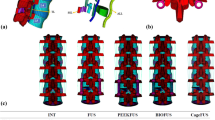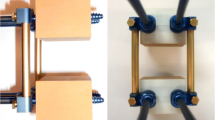Abstract
Posteriorly and anteriorly fixed implants for stabilizing unstable spines are available on the market. Differences in the biomechanical behavior of these implant types are not yet fully clear. They were investigated using three-dimensional nonlinear finite element models of the lumbar spine in an intact state, with an anteriorly fixed MACS-TL implant and with posteriorly fixed internal fixators. The bisegmental implants spanned the L3 vertebra, and bone grafts were used with both implant types to replace parts of the two bridged discs. The computer models were loaded with partial body weight and muscle forces simulating standing, flexion, extension and axial rotation. Both implant types have reduced intersegmental rotation for flexion, extension, and axial rotation in the bridged region. The reduction is more pronounced for the MACS-TL implant. The implant type has only a minor effect on intradiscal pressure. Maximum von Mises stresses in the vertebrae are lower for flexion and extension with the MACS-TL implant than with the internal fixator. Very high stresses are predicted for flexion after insertion of internal fixators. For standing and torsion, maximum stresses differ only negligibly between the two implant types. In the period immediately after surgery, patients with osteoporotic vertebrae and who are treated with an internal spinal fixation device should therefore avoid excessive flexion. This study adds new information about the mechanical behavior of the lumbar spine after insertion of posterior and anterior spine-stabilizing implants. This information improves our biomechanical understanding of the spine.







Similar content being viewed by others
References
Beisse R, Potulski M, Beger J, Buhren V (2002) Entwicklung und klinischer Einsatz einer thorakoskopisch implantierbaren Rahmenplatte zur Behandlung thorakolumbaler Frakturen und Instabilitäten. Orthopäde 31:413–422
Bogduk N, MacIntosh JE, Pearcy MJ (1992) A universal model of the lumbar back muscles in the upright position. Spine 17:897–913
Calisse J, Rohlmann A, Bergmann G (1999) Estimation of trunk muscle forces using the finite element method and in vivo loads measured by telemeterized internal spinal fixation devices. J Biomech 32:727–731
Goel VK, Monroe BT, Gilbertson LG, Brinckmann P (1995) Interlaminar shear stresses and laminae separation in a disc. Finite element analysis of the L3–L4 motion segment subjected to axial compressive loads. Spine 20:689–698
Goel VK, Ramirez SA, Kong W, Gilbertson LG (1995) Cancellous bone Young’s modulus variation within the vertebral body of a ligamentous lumbar spine—application of bone adaptive remodeling concepts. J Biomech Eng 117:266–271
Grupp TM, Beisse R, Potulski M, Marnay T, Beger J, Blomer W (2002) Mechanische Testung der Implantateigenschaften eines thorakoskopisch implantierbaren ventralen Wirbelsäulenstabilisierungssystems. Orthopäde 31:406–412
Patwardhan AG, Havey RM, Meade KP, Lee B, Dunlap B (1999) A follower load increases the load-carrying capacity of the lumbar spine in compression. Spine 24:1003–1009
Rohlmann A, Claes L, Bergmann G, Graichen F, Neef P, Wilke HJ (2001) Comparison of intradiscal pressures and spinal fixator loads for different body positions and exercises. Ergonomics 44:781–794
Rohlmann A, Neller S, Bergmann G, Graichen F, Claes L, Wilke HJ (2001) Effect of an internal fixator and a bone graft on intersegmental spinal motion and intradiscal pressure in the adjacent regions. Eur Spine J 10:301–308
Rohlmann A, Neller S, Claes L, Bergmann G, Wilke HJ (2001) Influence of a follower load on intradiscal pressure and intersegmental rotation of the lumbar spine. Spine 26:E557–E561
Rohlmann A, Zander T, Fehrmann M, Bergmann G (2003) Vergleich des mechanischen Verhaltens der Lendenwirbelsäule nach einer Stabilisierung mit einem ventralen bzw. dorsalen Implantat. BIOmaterialien 4:236
Schultheiss M, Wilke HJ, Claes L, Kinzl L, Hartwig E (2002) MACS-TL-twin-screw. Ein neues thorakoskopisch implantierbares Stabilisationssystem zur Behandlung von Wirbelfrakturen—Implantatdesign, Implantationstechnik und In-vitro-Testung. Orthopäde 31:362–367
Shirazi-Adl A, Ahmed AM, Shrivastava SC (1986) Mechanical response of a lumbar motion segment in axial torque alone and combined with compression. Spine 11:914–927
Smit T (1996) The mechanical significance of the trabecular bone architecture in a human vertebra. Shaker, Aachen, Germany
Wilke HJ, Neef P, Hinz B, Seidel H, Claes L (2001) Intradiscal pressure together with anthropometric data—a data set for the validation of models. Clin Biomech (Bristol, Avon) 16:S111–126
Wilke HJ, Claes L, Schmitt H, Wolf S (1994) A universal spine tester for in vitro experiments with muscle force simulation. Eur Spine J 3:91–97
Wilke HJ, Neef P, Caimi M, Hoogland T, Claes LE (1999) New in vivo measurements of pressures in the intervertebral disc in daily life. Spine 24:755–762
Wilke HJ, Rohlmann A, Neller S, Graichen F, Claes L, Bergmann G (2003) ISSLS Prize Winner: A novel approach to determine trunk muscle forces during flexion and extension. A comparison of data from an in vitro experiment and in vivo measurements. Spine 28:2585–2593
Zander T, Rohlmann A, Calisse J, Bergmann G (2001) Estimation of muscle forces in the lumbar spine during upper-body inclination. Clin Biomech (Bristol, Avon) 16:S73–80
Zander T, Rohlmann A, Klöckner C, Bergmann G (2002) Comparison of the mechanical behavior of the lumbar spine following mono- and bisegmental stabilization. Clin Biomech (Bristol, Avon) 17:439–445
Zander T, Rohlmann A, Klöckner C, Bergmann G (2002) Influence of bone graft characteristics on mechanical behavior of the spine. J Biomech 35:491–497
Acknowledgements
The original element mesh of the L4 vertebra was created by Smit. It is available on the internet at the ISB Finite Element Repository managed by the Instituti Ortopedici Rizzoli. Finite element analyses were performed at the Norddeutscher Verbund für Hoch- und Höchstleistungsrechnen (HLRN) and Zentraleinrichtung Rechenzentrum Berlin (ZRZ). The authors thank M. Fehrmann for assistance with the finite element calculations and Dr. J. Weirowski for editorial assistance. Funding for this study was obtained from the Deutsche Forschungsgemeinschaft, Bonn, Germany (Ro 581/13–3).
Author information
Authors and Affiliations
Corresponding author
Rights and permissions
About this article
Cite this article
Rohlmann, A., Zander, T. & Bergmann, G. Comparison of the biomechanical effects of posterior and anterior spine-stabilizing implants. Eur Spine J 14, 445–453 (2005). https://doi.org/10.1007/s00586-004-0784-3
Received:
Revised:
Accepted:
Published:
Issue Date:
DOI: https://doi.org/10.1007/s00586-004-0784-3




